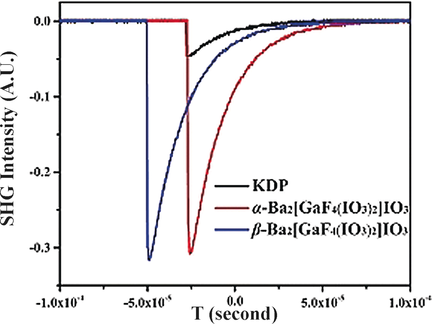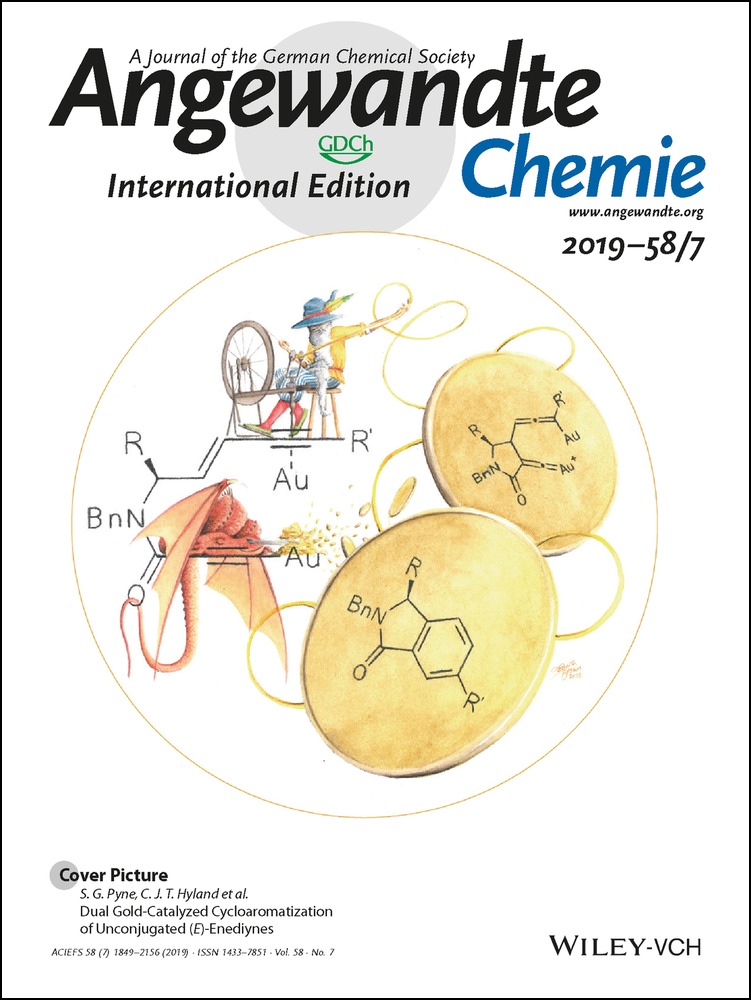A Facile Route to Nonlinear Optical Materials: Three-Site Aliovalent Substitution Involving One Cation and Two Anions
Jin Chen
State Key Laboratory of Structural Chemistry, Fujian Institute of Research on the Structure of Matter, Chinese Academy of Sciences, Fuzhou, 350002 P. R. China
University of the Chinese Academy of Sciences, Beijing, 100039 P. R. China
Search for more papers by this authorDr. Chun-Li Hu
State Key Laboratory of Structural Chemistry, Fujian Institute of Research on the Structure of Matter, Chinese Academy of Sciences, Fuzhou, 350002 P. R. China
Search for more papers by this authorDr. Fei-Fei Mao
State Key Laboratory of Structural Chemistry, Fujian Institute of Research on the Structure of Matter, Chinese Academy of Sciences, Fuzhou, 350002 P. R. China
Search for more papers by this authorDr. Jiang-He Feng
State Key Laboratory of Structural Chemistry, Fujian Institute of Research on the Structure of Matter, Chinese Academy of Sciences, Fuzhou, 350002 P. R. China
Search for more papers by this authorCorresponding Author
Prof. Jiang-Gao Mao
State Key Laboratory of Structural Chemistry, Fujian Institute of Research on the Structure of Matter, Chinese Academy of Sciences, Fuzhou, 350002 P. R. China
Search for more papers by this authorJin Chen
State Key Laboratory of Structural Chemistry, Fujian Institute of Research on the Structure of Matter, Chinese Academy of Sciences, Fuzhou, 350002 P. R. China
University of the Chinese Academy of Sciences, Beijing, 100039 P. R. China
Search for more papers by this authorDr. Chun-Li Hu
State Key Laboratory of Structural Chemistry, Fujian Institute of Research on the Structure of Matter, Chinese Academy of Sciences, Fuzhou, 350002 P. R. China
Search for more papers by this authorDr. Fei-Fei Mao
State Key Laboratory of Structural Chemistry, Fujian Institute of Research on the Structure of Matter, Chinese Academy of Sciences, Fuzhou, 350002 P. R. China
Search for more papers by this authorDr. Jiang-He Feng
State Key Laboratory of Structural Chemistry, Fujian Institute of Research on the Structure of Matter, Chinese Academy of Sciences, Fuzhou, 350002 P. R. China
Search for more papers by this authorCorresponding Author
Prof. Jiang-Gao Mao
State Key Laboratory of Structural Chemistry, Fujian Institute of Research on the Structure of Matter, Chinese Academy of Sciences, Fuzhou, 350002 P. R. China
Search for more papers by this authorDedicated to Professor Jin-Shun Huang on the occasion of his 80th birthday
Graphical Abstract
Trading places: Two new nonlinear optical materials, α- and β-Ba2[GaF4(IO3)2](IO3) (1 and 2), were designed via three-site aliovalent substitution of VO4F2 in α- and β-Ba2[VO2F2(IO3)2](IO3) by GaO2F4. The new materials display large second-harmonic generation responses (≈6×KH2PO4 (KDP)), wide energy band gaps (4.61 and 4.35 eV), and high laser damage thresholds (29.7× and 28.3× relative to that of AgGaS2).
Abstract
Two mixed-metal gallium iodate fluorides, namely, α- and β-Ba2[GaF4(IO3)2](IO3) (1 and 2), have been designed by the aliovalent substitutions of α- and β-Ba2[VO2F2(IO3)2](IO3) (3 and 4) involving one cationic and two anionic sites. Both 1 and 2 display large second-harmonic generation responses (≈6×KH2PO4 (KDP)), large energy band gaps (4.61 and 4.35 eV), wide transmittance ranges (≈0.27–12.5 μm), and high relevant laser-induced damage thresholds (29.7× and 28.3×AgGaS2, respectively), which indicates that 1 and 2 are potential second-order nonlinear optical materials in the ultraviolet to mid-infrared. Our studies propose that three-site aliovalent substitution is a facile route for the discovery of good NLO materials.
Supporting Information
As a service to our authors and readers, this journal provides supporting information supplied by the authors. Such materials are peer reviewed and may be re-organized for online delivery, but are not copy-edited or typeset. Technical support issues arising from supporting information (other than missing files) should be addressed to the authors.
| Filename | Description |
|---|---|
| anie201813968-sup-0001-misc_information.pdf1.9 MB | Supplementary |
Please note: The publisher is not responsible for the content or functionality of any supporting information supplied by the authors. Any queries (other than missing content) should be directed to the corresponding author for the article.
References
- 1J. L. Song, C. L. Hu, X. Xu, F. Kong, J. G. Mao, Angew. Chem. Int. Ed. 2015, 54, 3679–3682; Angew. Chem. 2015, 127, 3750–3753.
- 2G. Peng, N. Ye, Z. Lin, L. Kang, S. Pan, M. Zhang, C. Lin, X. Long, M. Luo, Y. Chen, Y. H. Tang, F. Xu, T. Yan, Angew. Chem. Int. Ed. 2018, 57, 8968–8972; Angew. Chem. 2018, 130, 9106–9110.
- 3G. H. Zou, H. Jo, S. J. Lim, T. S. You, K. M. Ok, Angew. Chem. Int. Ed. 2018, 57, 8619–8622; Angew. Chem. 2018, 130, 8755–8758.
- 4M. Mutailipu, M. Zhang, H. P. Wu, Z. H. Yang, Y. H. Shen, J. L. Sun, S. L. Pan, Nat. Commun. 2018, 9, 3089.
- 5W. Q. Lu, Z. L. Gao, X. T. Liu, X. X. Tian, Q. Wu, C. G. Li, Y. X. Sun, Y. Liu, X. T. Tao, J. Am. Chem. Soc. 2018, 140, 13089–13096.
- 6S. G. Zhao, X. Y. Yang, Y. Yang, X. J. Kuang, F. Q. Lu, P. Shan, Z. H. Sun, Z. H. Lin, M. C. Hong, J. H. Luo, J. Am. Chem. Soc. 2018, 140, 1592–1595.
- 7K. Wu, S. L. Pan, Coord. Chem. Rev. 2018, 377, 191–208.
- 8K. M. Ok, Acc. Chem. Res. 2016, 49, 2774–2785.
- 9Y. Pan, S. P. Guo, B. W. Liu, H. G. Xue, G. C. Guo, Coord. Chem. Rev. 2018, 374, 464–496.
- 10C. L. Hu, J. G. Mao, Coord. Chem. Rev. 2015, 288, 1–17.
- 11D. Phanon, I. Gautier-Luneau, Angew. Chem. Int. Ed. 2007, 46, 8488–8491; Angew. Chem. 2007, 119, 8640–8643.
- 12X. Xu, C. L. Hu, B. X. Li, B. P. Yang, J. G. Mao, Chem. Mater. 2014, 26, 3219–3230.
- 13K. M. Ok, P. S. Halasyamani, Angew. Chem. Int. Ed. 2004, 43, 5489–5491; Angew. Chem. 2004, 116, 5605–5607.
- 14R. E. Sykora, K. M. Ok, P. S. Halasyamani, T. E. Albrecht-Schmitt, J. Am. Chem. Soc. 2002, 124, 1951–1957.
- 15R. E. Sykora, K. M. Ok, P. S. Halasyamani, D. M. Wells, T. E. Albrecht-Schmitt, Chem. Mater. 2002, 14, 2741–2749.
- 16K. M. Ok, P. S. Halasyamani, Inorg. Chem. 2005, 44, 2263–2271.
- 17C. F. Sun, C. L. Hu, X. Xu, J. B. Ling, T. Hu, F. Kong, X. F. Long, J. G. Mao, J. Am. Chem. Soc. 2009, 131, 9486–9487.
- 18C. F. Sun, T. Hu, X. Xu, J. G. Mao, Dalton Trans. 2010, 39, 7960–7967.
- 19B. P. Yang, C. L. Hu, X. Xu, C. F. Sun, J. H. Zhang, J. G. Mao, Chem. Mater. 2002, 22, 1545–1550.
- 20C. F. Sun, C. L. Hu, X. Xu, B. P. Yang, J. G. Mao, J. Am. Chem. Soc. 2011, 133, 5561–5572.
- 21B. P. Yang, C. L. Hu, X. Xu, C. Huang, J. G. Mao, Inorg. Chem. 2013, 52, 5378–5384.
- 22B. P. Yang, X. Xu, C. Huang, J. G. Mao, CrystEngComm 2013, 15, 10464–10469.
- 23S. D. Nguyen, J. Yeon, S. H. Kim, P. S. Halasyamani, J. Am. Chem. Soc. 2011, 133, 12422–12425.
- 24Z. B. Cao, Y. C. Yue, J. Y. Yao, Z. S. Lin, R. He, Z. G. Hu, Inorg. Chem. 2011, 50, 12818–12822.
- 25C. F. Sun, C. L. Hu, J. G. Mao, Chem. Commun. 2012, 48, 4220–4222.
- 26E. L. Belokoneva, S. Y. Stefanovich, O. V. Dimitrova, A. S. Karamysheva, A. S. Volkov, Inorg. Chem. 2017, 56, 1186–1192.
- 27H. W. Yu, M. L. Nisbet, K. R. Poeppelmeier, J. Am. Chem. Soc. 2018, 140, 8868–8876.
- 28F. F. Mao, C. L. Hu, X. Xu, D. Yan, B. P. Yang, J. G. Mao, Angew. Chem. Int. Ed. 2017, 56, 2151–2155; Angew. Chem. 2017, 129, 2183–2187.
- 29Q. Wu, H. M. Liu, F. C. Jiang, L. Kang, L. Yang, Z. S. Lin, Z. G. Hu, X. G. Chen, X. G. Meng, J. G. Qin, Chem. Mater. 2016, 28, 1413–1418.
- 30H. M. Liu, Q. Wu, X. X. Jiang, Z. S. Lin, X. G. Meng, X. G. Chen, J. G. Qin, Angew. Chem. Int. Ed. 2017, 56, 9492–9496; Angew. Chem. 2017, 129, 9620–9624.
- 31M. Zhang, C. Hu, T. Abudouwufu, Z. H. Yang, S. L. Pan, Chem. Mater. 2018, 30, 1136–1145.
- 32M. Zhang, X. Su, M. Mutailipu, Z. H. Yang, S. L. Pan, Chem. Mater. 2017, 25, 945–949.
- 33H. Y. Chang, S. H. Kim, P. S. Halasyamani, K. M. Ok, J. Am. Chem. Soc. 2009, 131, 2426–2427.
- 34Y. H. Kim, T. T. Tran, P. S. Halasyamani, K. M. Ok, Inorg. Chem. Front. 2015, 2, 361–368.
- 35F. F. Mao, C. L. Hu, J. Chen, J. G. Mao, Chem. Mater. 2018, 30, 2443–2452.
- 36Z. G. Xia, K. R. Poeppelmeier, Acc. Chem. Res. 2017, 50, 1222–1230.
- 37T. Eaton, J. Lin, J. N. Cross, J. T. Stritzinger, T. E. Albrecht-Schmitt, Chem. Commun. 2014, 50, 3668–3670.
- 38M. L. Liang, C. L. Hu, F. Kong, J. G. Mao, J. Am. Chem. Soc. 2016, 128, 9433–9436.
- 39X. L. Cao, C. L. Hu, F. Kong, J. G. Mao, Inorg. Chem. 2015, 54, 3875–3882.
- 40F. Kong, X. Xu, J. G. Mao, Inorg. Chem. 2010, 49, 11573–11580.
- 41X. L. Cao, C. L. Hu, X. Xu, F. Kong, J. G. Mao, Chem. Commun. 2013, 49, 9965–9967.
- 42Crystal data of 1: a=13.6984(3) Å, b=11.3696(2) Å, c=7.4245(2) Å, α=β=γ=90°, V=1156.76(5) Å3. Crystal data of 2: a=7.4631(2) Å, b=7.4511(2) Å, c=10.9597(4) Å, α=γ=90°, β=106.138(3)°, V=585.24(3) Å3. CCDC 1881364 and 1881365 (1, 2) contain the supplementary crystallographic data for this paper. These data can be obtained free of charge from The Cambridge Crystallographic Data Centre. (See Supporting Information for details.).
- 43J. P. Laval, N. Jennene Boukharrata, P. Thomas, Acta Crystallogr. Sect. C 2008, 64, i 12-i14.
- 44P. S. Halasyamani, Chem. Mater. 2004, 16, 3586–3592.
- 45D. Phanon, A. Mosset, I. Gautier-Luneau, J. Mater. Chem. C 2007, 17, 1123–1130.
- 46X. Meng, F. Liang, M. Xia, Z. S. Lin, Inorg. Chem. 2018, 57, 5669–5676.
- 47P. A. Maggard, T. S. Nault, C. L. Stern, K. R. Poeppelmeier, J. Solid State Chem. 2003, 175, 27–33.
- 48H. K. Izumi, J. E. Kirsch, C. L. Stern, K. R. Poeppelmeier, Inorg. Chem. 2005, 44, 884–895.
- 49T. Sivakumar, Y. C. Hong, J. Baek, P. S. Halasyamani, Chem. Mater. 2007, 19, 4710–4715.
- 50J. Galy, G. Meunier, S. Andersson, A. Åström, J. Solid State Chem. 1975, 13, 142–148.





